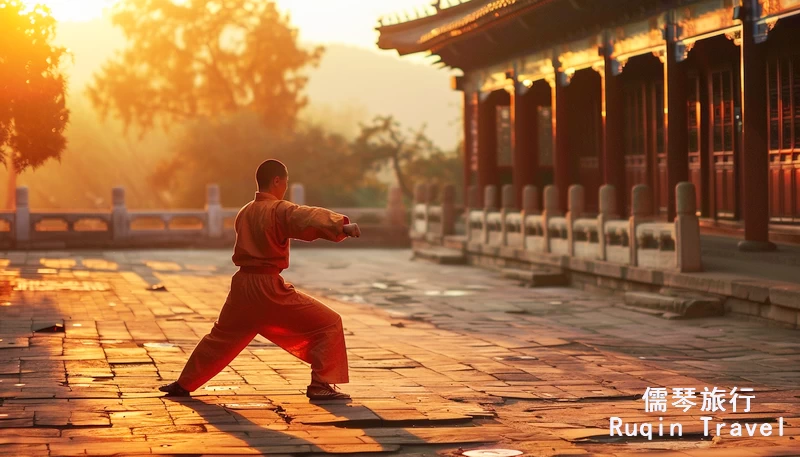Chinese martial arts, a profound and storied tradition, fascinate many around the world. Known for their grace, discipline, and effectiveness, these arts have captivated foreigners planning to visit China.
In this guide, we will explore the key aspects of Chinese martial arts, including their history, styles, and places to learn. This guide is tailored for tourists eager to dive into this cultural gem.
The Rich History of Chinese Martial Arts
Chinese martial arts, often referred to as Kung Fu or Wushu, date back thousands of years. The origins of these practices are intertwined with the history and culture of China itself.
Initially, martial arts were developed for self-defense, hunting, and military training. Over time, they evolved into a rich cultural heritage.
Ancient Beginnings
The earliest records of martial arts in China can be traced back to the Xia Dynasty (2070-1600 BCE). During this period, combat skills were honed for survival and warfare. As Chinese civilization progressed, these skills became more refined and formalized.
Influence of Philosophy and Religion
Confucianism, Taoism, and Buddhism have all significantly influenced Chinese martial arts. Confucianism emphasized moral integrity and discipline, while Taoism introduced concepts of balance and harmony. Buddhism, particularly through the Shaolin Monastery, integrated physical training with spiritual practice.
Evolution and Modernization
Throughout the centuries, Chinese martial arts continued to evolve. During the Ming and Qing Dynasties, they saw further development and categorization into various styles.
In the 20th century, with the founding of the People’s Republic of China, martial arts were promoted as a national sport, leading to the modern practice of Wushu.
Popular Styles of Chinese Martial Arts
Chinese martial arts encompass a wide range of styles, each with unique characteristics and techniques. Understanding these styles can help you choose which one to explore during your visit to China.
Kung Fu
Kung Fu is an umbrella term that refers to the entire spectrum of Chinese martial arts. It emphasizes physical fitness, flexibility, and mental discipline. Styles under Kung Fu include both external (hard) and internal (soft) forms.
Tai Chi
Tai Chi, known for its slow and flowing movements, focuses on internal strength and mindfulness. It is often practiced for health and longevity, making it suitable for all ages. Tai Chi emphasizes balance, coordination, and the harmonious flow of energy, or Qi.
Wushu
Wushu, a modern competitive form, combines traditional martial arts with performance elements. It includes both Taolu (forms) and Sanda (sparring).
Wushu is often showcased in international competitions and demonstrations, highlighting the beauty and athleticism of martial arts.
Shaolin Kung Fu
Shaolin Kung Fu, originating from the Shaolin Monastery, is one of the most famous styles. It integrates rigorous physical training with Zen Buddhism. Practitioners of Shaolin Kung Fu are known for their strength, agility, and endurance.
Learning Chinese Martial Arts in China
For foreigners visiting China, there are numerous opportunities to learn martial arts. Whether you are a beginner or an experienced practitioner, you can find a suitable program to enhance your skills.
Martial Arts Schools
China boasts numerous martial arts schools, especially in regions with historical significance. These schools offer various programs, from short-term courses to intensive training.
Shaolin Temple
The Shaolin Temple in Henan Province is a legendary place for martial arts enthusiasts. Here, you can immerse yourself in authentic Shaolin Kung Fu training, guided by experienced monks.
Wudang Mountains
The Wudang Mountains in Hubei Province are famous for Tai Chi and internal martial arts. Training here emphasizes harmony between body and mind, often set against the serene backdrop of the mountains.
Beijing Sport University
For those interested in modern Wushu, Beijing Sport University offers comprehensive programs. The university is a leading institution for martial arts education, attracting students from around the world.
Martial Arts Camps
Martial arts camps provide a unique experience for tourists. These camps are designed to introduce foreigners to Chinese martial arts in an immersive environment. You can participate in daily training sessions, cultural activities, and excursions to historical sites.
Short-Term Workshops
If you have limited time, consider attending short-term workshops. These workshops are often held in major cities like Beijing, Shanghai, and Guangzhou. They offer a condensed yet enriching introduction to various martial arts styles.
Martial Arts Tourism in China
Martial arts tourism is a growing trend, with many visitors traveling to China specifically to experience this cultural phenomenon. There are several ways to incorporate martial arts into your travel itinerary.
Visiting Martial Arts Academies
Many academies welcome visitors to observe or participate in training sessions. This provides a firsthand look at the discipline and dedication required in martial arts practice.
Attending Martial Arts Festivals
China hosts numerous martial arts festivals and competitions throughout the year. These events offer a spectacular display of skill and artistry. They also provide an opportunity to meet practitioners and learn more about different styles.
Exploring Historical Sites
Combine your martial arts interest with cultural exploration by visiting historical sites related to martial arts. The Shaolin Temple, Wudang Mountains, and Chen Village (the birthplace of Tai Chi) are all must-see destinations.
Chinese Martial Arts for Beginners
If you are new to martial arts, China is an excellent place to start your journey. Beginners are welcomed with open arms and can find programs tailored to their skill level.
Choosing the Right Style
Start by selecting a style that aligns with your interests and physical capabilities. Tai Chi is ideal for those seeking a gentle introduction, while Kung Fu offers a more vigorous workout.
Basic Techniques and Training
Beginner programs focus on foundational techniques, such as stances, strikes, and forms. Training typically includes a mix of physical exercise, technique practice, and meditation.
Cultural Immersion
Learning martial arts in China goes beyond physical training. You will also gain insights into Chinese culture, philosophy, and history. This holistic approach enhances your overall experience and understanding of martial arts.
Practical Tips for Martial Arts Enthusiasts
To make the most of your martial arts journey in China, consider these practical tips.
Plan Ahead
Research and plan your trip in advance. Identify the schools or camps you want to attend and check their schedules. Booking early can secure your spot and help you prepare better.
Health and Fitness
Ensure you are in good health and fitness before starting intense training. Consult with your doctor if necessary. Additionally, practice basic fitness routines to build your stamina and flexibility.
Respect Local Customs
Show respect for local customs and traditions. Martial arts training often involves etiquette and rituals. Understanding and following these practices will enhance your experience.
Learn Some Mandarin
While many schools have English-speaking instructors, learning basic Mandarin can be helpful. It shows respect for the local culture and can make your interactions smoother.
Pack Appropriately
Bring comfortable training clothes and appropriate footwear. Some schools provide uniforms, but it’s good to have your gear. Also, consider packing a first aid kit and any personal medications.
Exploring Chinese martial arts as a foreigner offers a unique and enriching experience. From the rich history and diverse styles to the immersive training opportunities, there is much to discover.
Whether you are a beginner or an experienced practitioner, China provides a perfect backdrop for your martial arts journey. By following this guide, you can make the most of your visit and delve deep into the fascinating world of Chinese martial arts.



